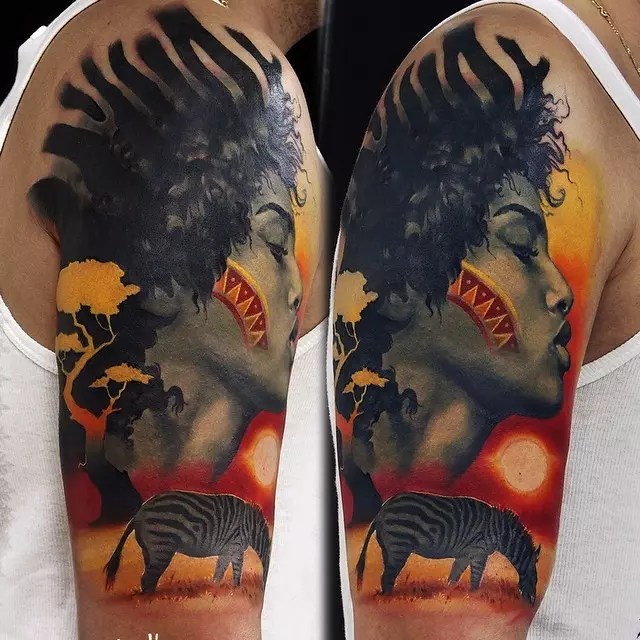Tattoos of different nations. Africa is the world center of tattooing African tattoos meaning
Nowadays, attitudes towards tattoos can be extremely opposite. Some attribute to the owners of tattoos “showing off”, “playing for the audience”. Others see nothing but art and “decorate” their body in every possible place. Today, you can get any tattoo without any problems, as well as use the skills of “body painters” for decorative and cosmetic purposes: tattoo your lips, eyes, and correct your eyebrows. But few people have thought about and know where this art came to us from.
Tattoos began to be used a long time ago. Africa can confidently be called the birthplace of this art. Since ancient times, each tribe had its own traditions, which also extended to tattooing. An important factor contributing to the widespread use of tattoos in Africa is the hot climate, which allows people to show off their bodies all year round. In addition to tattoos, Africans used scarring, all kinds of piercings, etc. to decorate their bodies.
The purpose and meaning of tattoos in Africa
When decorating the body, a number of purposes were pursued, among which decorative was far from the main one. Tattoos are, first of all, insignia. According to them, tribes differed from each other; they reflected a person’s social status, his position within the tribal hierarchy, and worldview. Tattoos served to protect against evil spirits.
It was possible to “read life” using body signs: in addition to status signs, “event” signs (let’s call them that) are common, which are applied after a certain milestone in a person’s life is passed: entry into adulthood, marriage, birth of a child. Tattoos were applied to both men and women. Male body marks usually characterized their owner as a hunter or warrior, and from female ones one could “read” whether their owner was married, had children, etc.
Symbols
When applying tattoos, their location, size, color, and color intensity played an important role. Sizes and colors were often specific to each tribe or family.
“Patterns” are usually simple. Figures of animals, plants, as well as symbols denoting spirits and ancestors were chosen as ornaments for application.
Social meaning of tattoos in Africa
For the vast majority of African tribes, to this day, the absence of a tattoo is a sign of inferiority. It is believed that a man without a body sign will not become a successful hunter, and a woman will not be able to start a family. Due to the fact that tattooing occupies such an important place in the life of tribes, the ritual itself is treated with great reverence in Africa, and only a select few are initiated into its sacrament.
Africa is a continent, in most of which, clothing is needed purely symbolically.
The climate of these places makes it possible to do without it almost all year round, if not for moral principles.
However, among the majority of the indigenous population, these principles are kept to a minimum and that is why clothing for them in everyday life consists mainly of a loincloth for men and something like a skirt for women; children usually make do with what nature has given.
But the proverb: “You meet people by their clothes...” is also valid for those who have a minimum of clothes. That is why it was customary for ancient African tribes all over the world to decorate their bodies with various designs.
Many ancient people used various paints for these purposes, which did not last long on the skin. So the American Indians applied war paint only for the duration of hostilities, and the Indians made wedding drawings only for the duration of the wedding, then the Africans went further. They drew pictures of their face and body with beauty, and then used needles to inject this beauty into the skin tissue. Such drawings remained on a person’s body all his life. These designs are called tattoos.

On the Dark Continent, since ancient times, it has become a custom to give tattoos to almost everyone. By the design of the tattoos, you can determine which tribe this person is from, and at what level of the hierarchy he stands in his tribe. The tattoo was a kind of calling card. Why did the Africans need this?
But everything is simple and for them a tattoo is both an adornment and a kind of business card that showed anyone they met what kind of tribe they were, what their position in society was, what their social status was. Just as Europeans determined a person’s nobility by clothing and hairstyle, so Africans recognized who was in front of him and how to treat him by tattoos.

Well, since the African climate allows you to display designs on your body all year round, these decorations have become common for everyone. Africans have made the process of tattooing a real art, achieving unsurpassed skill in this.
In general, tattoos are not considered purely feminine or masculine decoration. They are used by both men and women, the only difference is in the patterns and places of their application. By the man’s drawing you can determine that this is a warrior or a simple hunter. The leader and his relatives have special designs; only the leader’s clan can wear them. Having seen such a design on the body, even representatives of another tribe are obliged to pay tribute to it.
For women, you can determine from their drawing whether she is married or not, what her husband’s status is in society, and even how many children she has. If a woman has been married several times, this is also reflected by tattoos on her body. In many tribes, this serves as a reason for treating her with respect or not.

Different tribes have their own tattoo technologies and designs. They used and are now using various types of tattoos: actual tattoos, piercings, and the application of certain scars. Among Africans living in the northern regions of Africa, who have fair skin, tattoos are also popular.
In most tribes, tattooing usually has a special ritual character. It is performed as a kind of sacred rite. This is done by special people allowed to do this, with selected members of the tribe present, often the shaman performs a certain ritual.
.jpg)
The variety of tattoos is very large. So some people get tattoos on their arms or thighs, while others have scars on their heads and chests. So in banda, designs are applied to the chest, back and arms. What is considered beautiful and necessary in some tribes is not accepted in others, so among the Yaounde tribe in Cameroon, women were previously ordered to have scars on their thighs, in other tribes this is considered unlawful.
Tattoos are also made for children. Moreover, for this they use some natural dyes, as well as ash or even saltpeter. Such tattoos last a lifetime and are practically impossible to remove.

Tattooing in Africa, just as it was popular in ancient times, is also popular in modern times. A person with patterns on his body is not surprising, but on the contrary, he is a full-fledged member of society who requires a certain respect for himself. These are their morals. Although over time, tattoos have become popular among many people around the world. If a few decades ago in our country a tattoo was mainly an attribute of the zone and “gentlemen of fortune”, well, sometimes those who served in the army gave themselves such marks, but now tattoos are very common among young people and there is a whole direction in the cosmetics business that is in high demand.
On the beach you can meet any number of young people, including girls and women with tattoos on different parts of the body, and this is not considered shameful, but on the contrary, attracts attention.
“Children, don’t go for a walk in Africa,” Korney Ivanovich Chukovsky appealed to our prudence. And it’s not in vain, I must say, that he cried out: this anciently populated continent is rightfully considered the birthplace of tattooing. And the number of traditional themes for tattoos here is so diverse that especially impressionable people are in danger of leaving the shores of the Limpopo blue as duct tape (however, this is not even the worst thing, but a real possibility of getting blood poisoning when trying to get a tattoo with the hands of local craftsmen).
The history of tattooing on this continent goes back more than a thousand years. Iron confirmation of these words can serve as the mummy of Amunet, the priestess of the Goddess Hathor, who lived somewhere between 2160 BC -1994 BC. The patterns on her body are simple parallel lines on her arms and legs and an elliptical shape just below her navel. According to scientists, these patterns symbolize youth and fertility. Tattoos are also often found on male mummies: mainly, these are graphic symbols and images of various Gods.
Naturally, tattooing in Africa flourished (and is still very widespread) not only in developed countries, but also in individual tribes. This gave rise to a variety of possible African-style tattoos. For the most part, they historically had a hierarchical function within the tribe and information mative beyond its borders (eloquently indicating the geographical location of the homeland of the tattoo bearer), and also acted as amulets from evil spirits and were indispensable attributes of religious rites.
Since they were historically made on dark skin, they differ from other types by specific properties: a bright range of colors, dense color filling (and in the traditional form, also intentional scarring to add volume). thus, they are simply created for dark-skinned and simply dark-skinned people. However, they look great on fair skin too.
One of the most common images of African tattoos: adinkra symbols, characteristic of the tribes of West Africa. Let's look at the most commonly used ones.
So, the main sign of adinkra: a symbol of greatness, bright charisma and leadership.
God of War Akoben: symbolizes vigilance and caution

Akofena - Sword of War. Symbol of courage, valor and heroism

Akoko Nan - Chicken leg. Symbol of will, education and discipline

Akoma - Heart. Symbol of tolerance, tolerance and patience

Akomo Ntoso - Connected Hearts. Symbol of mutual understanding and harmony
Ananse Ntoman - The Web. Symbol of wisdom, creativity and complexity of life

Azaze e duru - "The earth has weight." Symbol of the providence and divine essence of Mother Earth

Aya - fern. Symbol of endurance and resourcefulness

Bese saka - a bag of kola nuts. Symbol of wealth, power, community and unity
Bi nka bi - “no one should bite others.” Symbol of peace and harmony

Wona me na me mmoa vo - “help me and let me help you.” Symbol of cooperation and connection

To the lady - to the lady - Game field. Symbol of intelligence and ingenuity

Denkyem - Crocodile. Symbol of high adaptability

Duafe - wooden comb. Symbol of beauty, purity and femininity

Dvenniman - ram's horns. A symbol of both strength and humility

Eban - fence. Symbol of love, safety and preservation of feelings
Epa - handcuffs. A symbol of law, justice, as well as slavery and captivity

Funtunfunemu - denkyemfunemu - Siamese crocodile. Symbol of democracy and unity.

Gye Nyam - "except for God." Symbol of God's supremacy

Quintincantan - "inflated extravagance." Symbol of arrogance

Kwatakye Atiko - Hairstyle of the leader of the army. Symbol of courage and valor

Mate mise - "what I hear, I remember." Symbol of wisdom, knowledge and prudence

Me ware vo - “I will marry you.” Symbol of commitment and perseverance

Ese ne tekrema - “with teeth and tongue.” Symbol of friendship and trust

Favohodi - Independence. Symbol of independence, freedom and emancipation

Khwe mu dua - Merilo. Symbol of quality
Hieu won Hieu - “that which does not burn. A symbol of indestructibility and perseverance. Today, tattoos depicting various Afican deities are easily made even by people who have nothing in common with the pagan religions of the tribes of this continent, and who are, in essence, indifferent to culture. After all, such tattoos look very nice, original and shrouded in an aura of mystery. The latter property, however, is not surprising: the culture of the tribes of the hottest part of the world has not yet been thoroughly studied, images of objects of worship do not have an unambiguous interpretation, which means that every bearer of a tattoo with an African deity can invest its meaning has its own meaning.
In general, no matter how you look at it, an African tattoo is always interesting, beautiful and mysterious. The creativity of craftsmen of various tribes opens up countless horizons of inspiration, from which you can draw endlessly. Anyone with a strong desire can find an attractive tattoo option in the rich and diverse culture of their homeland. Good luck!
Africa is a vast continent and it always attracts the fascinations of the rest of the world through its interesting traditions, fantastic wildlife, and intense landscape. This land is also known as the cradle of humanity. The Africans are facing poverty, capitalist exploitation and climate changes.
However, they are also popular for their ancestral knowledge and art. Most of the modern body arts are originated from the African tribal body art. Many African tribes decorate their body by using body paints, mud, shaving, piercing, etc. Here is an analysis of African tattoos.
Contents:


History Of African Tattoo Designs
African tattoos fascinate the eyes of all tattoo lovers. These tattoos originated in Bronze age, which means around 5000 years ago. People belonged to different cultures and races practiced these tattoos. Most African tattoo designs signify boldness and courage.

Europeans considered tattoos as a symbol of membership. These tattoos were stunning and beautiful. They also provide significant and traditional appearance. Today, African tattoos are very popular among men and women and its popularity is increasing constantly.
Therefore, the demand for these tattoo designs is very high these days.



Where to Put African Tattoos?
African tattoo designs look great and they can be placed any part of your body. Just like other tattoos, African tribal tattoos also have many variations. Depending on the type of your skin, these tattoos can produce different looks.
Though African tribal tattoos are popular among men, women also love to wear these types of tattoos. It is not hard to find some best African tattoo designs. These tattoos are very simple, but myriad options are available.

So, you can select the best tattoo design by sifting through the catalogs and online tattoo galleries. African tattoo designs have different look and feel. While some designs have looping elements, some others have more jagged appearance. So, you must decide the right look and feel you really need.




You must also consider the color of the tattoo. Mostly, people like to get black tattoo designs. But, you can add some colors to get individuality and flare. The meaning of African tribal tattoo designs varies depending on the color of the tattoos.
But, if you want to tattoo your body for aesthetic reasons, just forget about the meaning.

You can place African tribal tattoos in almost all parts of your body. However, depending on your gender, you can select the place. Stretch tattoos can be portrayed very beautifully on your back. Men prefer to depict their African tattoo design on their upper back.
But, women prefer to place it on both upper and lower back. You can also place it on your fingers, arms, feet, legs, ankles, etc.



Meaning Of Africa Tattoos
The meaning of African tattoos are derived from the culture of this nation. The nature of traditional African people was superstitious. Some people wore tribal tattoos to get protection from all sorts of harm throughout their life. They considered tattoos as a sort of protective mask.
So, they believed that the tattoos are connected with some powers. By tattooing their body, people thought that they will get protection throughout their life.

In this modern day, African tattoo arts are merely for decoration and they have no values. But, the traditional minded people consider that this art makes them supernatural and they will be able to overcome the evil.
Instead of tattooing, they used the term scarification because they think that this art makes the wearer more than just human, but supernatural.



The Africans tattooed their body to portray their character. Through scarification or tattoos, these people reveal their brevity and courage. Scarification is very painful. Immense strength is needed to do this art. Africans use different symbols while designing their body. The visual symbols, Adinkra was created in West Africa by Gyaman of Cote and Akan of Ghana. It represents aphorisms or concepts.
African tattoos also signify beauty. The Africans start the process of beautification from childhood. Though there are other reasons for tattooing, quest for beauty is their ultimate goal. Spirituality plays a significant role in the culture of African people.

Most of the people believed that the spirit is around them. By making facial tattoos, they believed that the tattoo wearer would be less desirable to the spirit of death. Young women often wear abdominal tattoos, which is the indication of their willingness to bear children.
African culture considers it as the most desirable quality of future wife.
Types of African Tattoos
- Intricate Tattoos.
Lots of details and attention are needed for making an intricate African tattoo design. Solid black color is used for designing these tattoos. So, it provides sharp and masculine appearance. Lots of focus is essential to make an intricate design. Therefore, you must select an excellent artist to make this design.


- Powerful Tattoos.
African tattoos are pieces of human body art. These were organized by people who committed various crimes. Therefore, the appearance of these designs was distinct and different. These designs are the symbol of power and authority. You can select lots of beautiful designs in this category.
- African Tribal Celtic.
These are highly attractive and unique. Difficult patterns and sinuous lines are used for making these designs. You can also find innumerable animal designs as well. But most of them are associated with religion and fertility.

- African Elephant Tattoos.
If you are animal lover, you can decorate your body with African elephant tattoo designs. These tattoos represent strength, simplicity and humanity. Elephants are enormous creatures, but they can be great companions. An African elephant design can be simply elegant and stunning.

- Flower Tattoos.
Flowers represent the beauty and purity of women. The pleasant appearance of flowers is great for tattoo designs. You can make a flower in African tattoo design, which will look beautiful, traditional and appealing.
- Butterfly Tattoos.
Butterfly tattoos are lovely and it looks more pleasant when it is portrayed in African style. These tattoos are creative, unique and beautiful when inked in side.

- Star Tattoos.
If you are looking for a cool African tribal design, star is the best option. You can combine starts with some great tribal embroidery and pattern.
- Floral Pattern.
Floral wave design can be done in your body. It can be extended if you require more. Dark black or maroon can be used for designing these tattoos.

- Full body Colorful Art.
You can select this type of tattoo design if you like colorful work in your entire body. But, removing these designs from your body is very difficult and costly. You need to spend a huge sum of money to get these designs off. So, before selecting this tattoo design, you must think very carefully.

- Tribal Bird. This design can be very fascinating. You can try these types of tattoo designs and customize it according to your style. Just talk to a design expert to get the best design.
Just like other tattoo designs, African tattoos also have different meanings depending on the symbols. So, you can select the most suitable tattoo as per your requirement. The meanings and symbols behind these tattoos will be interesting.
If you are least bothered about the meaning, you can understand the origins and symbolism behind your tattoo design. It will help you to add personality to your choice.
The history of Africa goes back several thousand years. As well as being the cradle of civilization, Africa is also the cradle of tattooing. But the origin of this art on its territory has a completely different history from others. And its main difference from the history of other continents is its incredible bloodiness.
African tribes have always been characterized by increased cruelty and sadism. Their methods of dealing with enemies make our contemporaries shudder. But the Africans were also merciless towards themselves, not allowing the slightest weakness for the representatives of their tribes. This is also proven by the fact that Africa is the only continent where all types of body decoration are simultaneously represented - scarring, piercings, and tattoos.
Climate played a major role in the development of tattoo art in Africa. In a country where clothing was not a particularly necessary attribute, and most of the body remained open, subcutaneous designs were very appropriate. They had a special meaning for their bearers and those around them.
For men, these were primarily indicators of his strength and masculinity. A real warrior was covered with images of various signs indicating the number of his victories and killed enemies. Also, these were signs of the spirits and ancestors who patronized him. But these could also be images of various predators or mythical creatures that were supposed to terrify the enemy and help the warrior win battles.

But the most curious and unexplored type of African tattoo was an ornament that was symmetrically applied to the human body. This type of tattoo was intended to attract a strong spirit and invite it to inhabit the human body. It was believed that the more interesting and beautiful the ornament, the more likely it is that a strong spirit will choose this particular person as its own container.
The exact purpose of this ritual still remains unexplored, leaving room for many theories.

Also, the tattoo served as a kind of passport in the other world and protection against theft of the soul. But again, there is very little information about this and an unplowed field for anthropologists to work on.
The process of tattooing occupied such an important place in the life of the tribes that it was performed only according to a strict ritual and only by the oldest representatives of the tribe.

If you pay attention to the motifs in tattoo designs, you will notice that the favorite theme of African artists is the theme of death. The most popular images were of skulls, snakes and dragons. These images are the most common in all corners of the planet and in their mass personify evil, dark power and demonic essence. It was also believed that these signs inextricably link their bearers with the lower world, or the underworld in our opinion. Africans believed that through these images, embossed under their skin, they received unprecedented power.

Currently, traditional African tattoos are not particularly popular in Europe. This is mainly due to the lack of understanding of such unusual cultures and rejection of the way of life of African tribes. Which is very upsetting, because this is a country permeated with mysteries and secrets, is the cradle of magic and the occult, and is much more closely connected with the mysterious forces of nature than others. its people are distinguished by their superior instinct and harmony with the surrounding world. But, perhaps due to the remoteness of its inhabitants, Europeans will not soon be able to understand this and truly appreciate their art.







